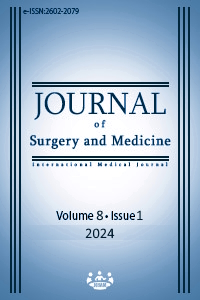Assessment of maternal and fetal outcomes according to induction methods following negative oxytocin challenge test
Negative oxytocin challenge test outcomes
Keywords:
fetal outcomes, labor induction, oxytocin challenge test, maternal outcomesAbstract
Background/Aim: There is insufficient information about how long fetal well-being will last after a negative oxytocin challenge test (OCT) and the factors affecting this process. We aim to evaluate maternal and perinatal outcomes in high-risk patients who had negative OCTs and to investigate the effects of methods of induction on the development of fetal distress.
Methods: The study was designed as a retrospective cohort study. Data of patients who were hospitalized in the perinatal intensive care unit due to high-risk pregnancies between January 2016 and December 2016 were reviewed retrospectively. The patient’s gestational age, gravidity, parity, and body mass index (BMI), risk factors leading to the OCT, labor induction methods used following a negative OCT, time from negative OCT to delivery, mode of delivery, and indications for cesarean section were recorded. In addition, data regarding fetal sex, birth weight, birth height, labor complications, Apgar scores at minutes 1 and 5, admission to the neonatal intensive care unit (NICU), indications for NICU admission, length of NICU stay, and stillbirth were also recorded.
Results: OCT was performed on 551 patients and was negative in 447 patients. Among patients with a negative OCT, labor induction was preferred in 427 (95.5%) patients. When fetal distress development was assessed according to the induction method used following a negative OCT, fetal distress developed in 9.1% of 427 patients who underwent labor induction.
Conclusion: When outcomes were considered in pregnant women with a negative OCT, it was observed that there were no fetal deaths and a limited number of newborns with low Apgar scores. Further randomized studies are needed to draw definitive conclusions.
Downloads
References
Boylan P. Intrapartum fetal monitoring. Bailliere's Clinical Obstetrics and Gynaecology. 1987;1(1):73-95. DOI: https://doi.org/10.1016/S0950-3552(87)80024-X
Apgar V. A proposal for a new method of evaluation of the newborn. Classic Papers in Critical Care. 1952;32(449):97.
Aarnoudse JG, Huisjes HJ, Gordon H, Oeseburg B, Zijlstra WG. Fetal subcutaneous scalp PO2 and abnormal heart rate during labor. Am J Obstet Gynecol. 1985 Nov 1;153(5):565-6. doi: 10.1016/0002-9378(85)90476-4. PMID: 4061520. DOI: https://doi.org/10.1016/0002-9378(85)90476-4
Holtzman RB, Banzhaf WC, Silver RK, Hageman JR. Perinatal management of meconium staining of the amniotic fluid. Clinics in Perinatology. 1989;16(4):825-38. DOI: https://doi.org/10.1016/S0095-5108(18)30605-5
Riley RJ, Johnson J. Collecting and analyzing cord blood gases. Clinical Obstetrics and Gynecology. 1993;36(1):13-23. DOI: https://doi.org/10.1097/00003081-199303000-00005
Sarnat HB, Sarnat MS. Neonatal encephalopathy following fetal distress: a clinical and electroencephalographic study. Archives of Neurology. 1976;33(10):696-705. DOI: https://doi.org/10.1001/archneur.1976.00500100030012
Vintzileos AM, Gaffney SE, Salinger LM, Kontopoulos VG, Campbell WA, Nochimson DJ. The relationships among the fetal biophysical profile, umbilical cord pH, and Apgar scores. American Journal of Obstetrics and Gynecology. 1987;157(3):627-31. DOI: https://doi.org/10.1016/S0002-9378(87)80018-2
Różańska-Walędziak A, Czajkowski K, Walędziak M, Teliga-Czajkowska J. The Present Utility of the Oxytocin Challenge Test—A Single-Center Study. Journal of Clinical Medicine. 2020;9(1):131. DOI: https://doi.org/10.3390/jcm9010131
Freeman RK, Garite TJ, Modanlou H, Dorchester W, Rommal C, Devaney M. Postdate pregnancy: utilization of contraction stress testing for primary fetal surveillance. American Journal of Obstetrics and Gynecology. 1981;140(2):128-35. DOI: https://doi.org/10.1016/0002-9378(81)90099-5
Freeman RK, Dorchester W, Anderson G, Garite TJ. The significance of a previous stillbirth. American Journal of Obstetrics and Gynecology. 1985;151(1):7-13. DOI: https://doi.org/10.1016/0002-9378(85)90414-4
Druzin M, Karver M, Wagner W, Hutson J, Waltner A, Kogut E. Prospective evaluation of the contraction stress and nonstress tests in the management of post-term pregnancy. Surgery Gynecology & Obstetrics. 1992;174(6):507-12.
Gabbe SG, Mestman JH, Freeman RK, Anderson GV, Lowensohn RI. Management and outcome of class A diabetes mellitus. American Journal of Obstetrics and Gynecology. 1977;127(5):465-9. DOI: https://doi.org/10.1016/0002-9378(77)90436-7
Lagrew DC, Pircon RA, Towers CV, Dorchester W, Freeman RK. Antepartum fetal surveillance in patients with diabetes: when to start? American Journal of Obstetrics and Gynecology. 1993;168(6):1820-6. DOI: https://doi.org/10.1016/0002-9378(93)90696-G
Obstetricians ACo, Gynecologists. ACOG practice bulletin no. 107: induction of labor. Obstet Gynecol. 2009;114:386-97. DOI: https://doi.org/10.1097/AOG.0b013e3181b48ef5
Alfirevic Z, Keeney E, Dowswell T, Welton NJ, Medley N, Dias S, et al. Which method is best for the induction of labor? A systematic review, network meta-analysis and cost-effectiveness analysis. Health Technology Assessment. 2016;20(65):1-583. DOI: https://doi.org/10.3310/hta20650
Gabbe S, Jennifer R, Simpson J. Obstetrics: normal and problem pregnancies. Philadelphia. Elsevier/Saunders; 2012.
Freeman RK. The use of the oxytocin challenge test for antepartum clinical evaluation of uteroplacental respiratory function. American Journal of Obstetrics and Gynecology. 1975;121(4):481-9. DOI: https://doi.org/10.1016/0002-9378(75)90079-4
Hadi H. Cervical ripening and labor induction: clinical guidelines. Clinical Obstetrics and Gynecology. 2000;43(3):524-36. DOI: https://doi.org/10.1097/00003081-200009000-00012
Adair CD. Nonpharmacologic approaches to cervical priming and labor induction. Clinical Obstetrics and Gynecology. 2000;43(3):447-54. DOI: https://doi.org/10.1097/00003081-200009000-00005
Schifrin BS, Lapidus M, Doctor G, Leviton A. Contraction stress test for antepartum fetal evaluation. Obstetrics and Gynecology. 1975;45(4):433-8.
Hayden BL, Simpson JL, Ewing DE, Otterson WN. Can the oxytocin challenge test serve as the primary method for managing high-risk pregnancies? Obstet Gynecol. 1975 Sep;46(3):251-4. PMID: 1161226.
Cammu H, Martens G, Ruyssinck G, Amy J-J. Outcome after elective labor induction in nulliparous women: a matched cohort study. American Journal of Obstetrics and Gynecology. 2002;186(2):240-4. DOI: https://doi.org/10.1067/mob.2002.119643
Vahratian A, Zhang J, Troendle JF, Sciscione AC, Hoffman MK. Labor progression and risk of cesarean delivery in electively induced nulliparas. Obstet Gynecol. 2005 Apr;105(4):698-704. doi: 10.1097/01.AOG.0000157436.68847.3b. PMID: 15802393. DOI: https://doi.org/10.1097/01.AOG.0000157436.68847.3b
Evertson LR, Gauthier RJ, Collea JV. Fetal demise following negative contraction stress tests. Obstet Gynecol. 1978 Jun;51(6):671-3. PMID: 662243.
Nageotte MP, Towers CV, Asrat T, Freeman RK, Dorchester W. The value of a negative antepartum test: contraction stress test and modified biophysical profile. Obstet Gynecol. 1994 Aug;84(2):231-4. PMID: 8041536.
Downloads
- 597 1182
Published
Issue
Section
How to Cite
License
Copyright (c) 2024 Okan Aytekin, Sezin Erturk Aksakal, Mehmet Metin Altay
This work is licensed under a Creative Commons Attribution-NonCommercial-NoDerivatives 4.0 International License.
















